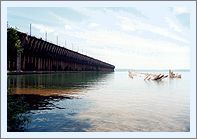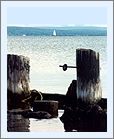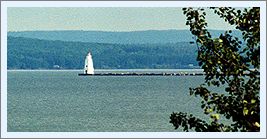|
Historical Information

By the 1880's much of the white pine had been clear-cut from the
shores of the lower lakes, and many lumbermen turned their attention to
the as yet untouched bounty of Lake Superior's forests. Soon, a fleet of
lumber hookers were making their way along the southern shore, hungry
for lumber produced by the growing number of mills being constructed in
the area's natural harbors and river mouths.
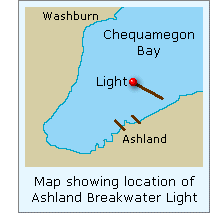 As the mills came, so did the workers,
and soon such towns as Grand Marais, Marquette, Ontonagon and Ashland
sprang up around them. However, while lumber was the seed from which
Ashland sprouted, it would be another natural bounty from deep within in
the forest that would really put the town on the map. As the mills came, so did the workers,
and soon such towns as Grand Marais, Marquette, Ontonagon and Ashland
sprang up around them. However, while lumber was the seed from which
Ashland sprouted, it would be another natural bounty from deep within in
the forest that would really put the town on the map.
Though iron ore had been discovered in
the Gogebic range in 1848, exploration did not begin until the 1860's.
By virtue of being the closest natural harbor, the first shipment of
Gogebic ore was made from Ashland in 1884. With the construction of
railroads from the range to the harbor towards the end of the decade,
vessels began lining-up to load ore at the increasing number of docks
being built along the shore, and Ashland's boom times were on.
By virtue of its location at the foot
of Chequamegon Bay, Ashland's docks were directly exposed to the full
fury of Superior's violent northeast winds. In 1889 the US Army Corps of
Engineers began construction of a massive breakwater stretching across
the entire bay to protect the exposed docks.
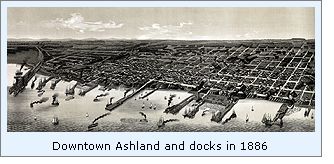 Beginning at a point approximately
2,000 feet from the southeast shore, by 1893 the slab and rock
breakwater had grown to a length of almost a mile-and-a-half. The
breakwater thus protecting almost 1,600 acres of water, and a total of
three miles of harbor front. Construction on a second parallel
breakwater to protect the southern opening began in 1900, while work
continued on the original structure with the addition of rip rap on both
sides and granite capping to provide additional durability. Beginning at a point approximately
2,000 feet from the southeast shore, by 1893 the slab and rock
breakwater had grown to a length of almost a mile-and-a-half. The
breakwater thus protecting almost 1,600 acres of water, and a total of
three miles of harbor front. Construction on a second parallel
breakwater to protect the southern opening began in 1900, while work
continued on the original structure with the addition of rip rap on both
sides and granite capping to provide additional durability.
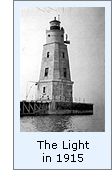 By 1910, the breakwater was
well-serving its intended purpose, however its uninterrupted length was
itself creating a problem to vessels masters who were finding it
difficult to locate the northern entrance to the harbor in the dark of
night. Responding to the problem, the Lighthouse Board installed a
temporary fixed red lens-lantern on a pole ten feet above the western
end of the breakwater, with care of the light assumed by the Army Corps
of Engineers while they continued with the harbor improvements. By 1910, the breakwater was
well-serving its intended purpose, however its uninterrupted length was
itself creating a problem to vessels masters who were finding it
difficult to locate the northern entrance to the harbor in the dark of
night. Responding to the problem, the Lighthouse Board installed a
temporary fixed red lens-lantern on a pole ten feet above the western
end of the breakwater, with care of the light assumed by the Army Corps
of Engineers while they continued with the harbor improvements.
In 1912, with the final ending point of
the breakwater established, the Lighthouse Board requested an
appropriation of $25,000 for the construction of a crib at the
breakwater's northwestern end, on which it was proposed an acetylene
light and fog bell would be installed. Congress responded favorably with
the requested appropriation on October 22, 1813, and plans for the
station drawn-up at the Detroit lighthouse depot that same year.
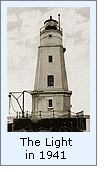 The plans for the proposed station
called for a unique design. Constructed of steel-reinforced concrete, it
was to be poured in place with the use of sectional forms. Illumination
was to be provided by an electrically operated lamp, with power supplied
from the Ashland generating station by way of a submarine cable to be
laid across the harbor floor. To keep costs low, the keeper's quarters
and boat house were to be built on shore in Ashland, with the keeper
servicing the light by boat. The plans for the proposed station
called for a unique design. Constructed of steel-reinforced concrete, it
was to be poured in place with the use of sectional forms. Illumination
was to be provided by an electrically operated lamp, with power supplied
from the Ashland generating station by way of a submarine cable to be
laid across the harbor floor. To keep costs low, the keeper's quarters
and boat house were to be built on shore in Ashland, with the keeper
servicing the light by boat.
Construction began on the structure in
the summer of 1914 and continued through the year until the storms of
winter made conditions intolerable. Resuming on the opening of
navigation in 1915, the station gradually took shape through that
summer.
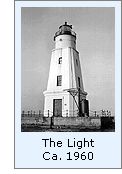 By October, the completed white-painted
concrete tower stood fifty-eight feet in height. Based on an octagonal
lower section seventeen feet square, the tower tapered gracefully to
fourteen feet square at its uppermost. Atop this concrete section, a
prefabricated circular iron watchroom thirteen feet in diameter an eight
feet in height was capped by an iron gallery, with a circular iron
lantern with helical astragals at its center. The lantern was equipped
with a Fourth-Order Fresnel lens, with illumination supplied by a single
1,600 candlepower electric lamp, displayed at a focal plane of
sixty-five feet. By October, the completed white-painted
concrete tower stood fifty-eight feet in height. Based on an octagonal
lower section seventeen feet square, the tower tapered gracefully to
fourteen feet square at its uppermost. Atop this concrete section, a
prefabricated circular iron watchroom thirteen feet in diameter an eight
feet in height was capped by an iron gallery, with a circular iron
lantern with helical astragals at its center. The lantern was equipped
with a Fourth-Order Fresnel lens, with illumination supplied by a single
1,600 candlepower electric lamp, displayed at a focal plane of
sixty-five feet.
The light was exhibited for the first
time on the evening of October 15, 1915, its characteristic one second
flashes followed by two-second eclipses visible from a distance of
sixteen miles at sea.
The station was also equipped with an
electrically-powered fog siren, programmed to provide repeating 4 second
blasts followed by 16 seconds of silence. The compressor and air tank
powering this horn were located in the tower's first floor, with
compressed air piped to the diaphone horn, located on the offshore side
of the watchroom.
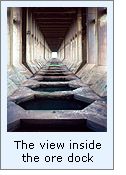 While the keeper's dwelling was located
onshore some two miles away, minimal living quarters were provided on
the second and third floors of the tower for those situations in which
weather conditions made travel across the harbor too dangerous, and the
keeper was forced to stay on station to ensure continued operation of
the light and fog signal. While the keeper's dwelling was located
onshore some two miles away, minimal living quarters were provided on
the second and third floors of the tower for those situations in which
weather conditions made travel across the harbor too dangerous, and the
keeper was forced to stay on station to ensure continued operation of
the light and fog signal.
The harbor improvements contributed
significantly to Ashland's growing prominence as an ore shipping port,
and as a result the first ore dock was constructed from 1916. At 900
feet in length, it was increased toe 1,800 feet in 1925, and was soon
joined by four similar massive structures along the waterfront, each
shipping in excess of a million tons of ore each year.
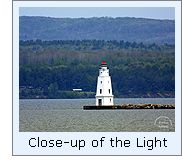 Ashland Breakwater Light stood faithful
vigil over the harbor through the halcyon years of the first half of the
twentieth century, and in turn stood silent witness to the declining
years of the 1950's and 60's. By the latter decades of the century, the
docks stood empty and decaying, and many of the people who came to
Ashland to support the iron boom moved on to seek their fortunes
elsewhere. Ashland Breakwater Light stood faithful
vigil over the harbor through the halcyon years of the first half of the
twentieth century, and in turn stood silent witness to the declining
years of the 1950's and 60's. By the latter decades of the century, the
docks stood empty and decaying, and many of the people who came to
Ashland to support the iron boom moved on to seek their fortunes
elsewhere.
In an ongoing system-wide effort to
reduce ongoing maintenance costs, the Coast Guard removed the Fresnel
lens from the lantern in 1980, and installed a 12-volt DC solar-powered
250mm acrylic optic in its place.
While the Breakwater Light still
functions as an active aid to navigation today, the harbor no longer
serves the commercial importance it did in the first half of the
twentieth century. Though the light no longer guides the huge ore boats
into the harbor, it serves is a welcome sight to the many pleasure
boaters returning to the harbor.

Keepers of
this Light

Click here
to see a complete listing of all Ashland Breakwater Light keepers compiled by Phyllis L.
Tag of Great Lakes Lighthouse Research.

Seeing this Light

Our information stated that Ashland Breakwater light was situated at the
end of a mile-long breakwater, which protects the once-busy port of
Ashland.
The weather was sunny and warm, with a light breeze, so we were looking
forward to a pleasant walk along the breakwater to the lighthouse.
A park just west of the small downtown area afforded us our first
glimpse of the structure, approximately a mile out in the lake, so we
pulled-off and walked to the lakeshore to get a better look. There were
remnants of an old shipping dock hutting from the park, and we walked
out onto part of the dock in order to get a better overall shot of the
lighthouse.
From this vantage point we could see that the pier was not joined to the
land at either end, and thus we would have to be satisfied with the
picture of Ashland light behind some of the old dock piling seen above.
We will be returning to
Ashland during our 2001 fall field trip, and have made arrangements to
take a boat tour which will pass close to the tower, and thus expect to
have greatly improved photographs of the structure when we return from
that trip. If you would like to receive an email when these new images
are posted, return to our home page, and click on the "Mailing
List" button.

Finding this
Light

Hwy 2 runs right through Ashland along the bay shore. Views of the
lighthouse can be frequently seen. As indicated above, without a boat
the lighthouse is inaccessible, since the breakwater upon which it sits
is not attached to land. Bayview Park can be found on the bay side of
Hwy 2 just Southwest of town, and offered the best view of the
lighthouse that we could find.

Reference
Sources
 Lake Carrier's Association Annual Reports, 1907 -
1914 Lake Carrier's Association Annual Reports, 1907 -
1914
Lighthouse Board Annual Reports, 1907 - 1909
Bureau of Lighthouses Annual reports, 1910 - 1920
Great Lakes Light List, 1924.
The Northern Lights, Charles K, Hyde, 1986
Lake Superior, Grace Lee Nute, 1944
The Long Ships Passing, Walter Havighurst, 1942
Personal visit to Ashland on
09/07/1999
Photographs from author's personal
collection.
Photograph from the USCG Historian's office.
Photograph from the Lake Carrier's Association.
Keeper listings for this light appear
courtesy of Great
Lakes Lighthouse Research
|
